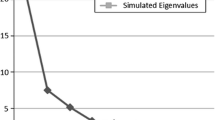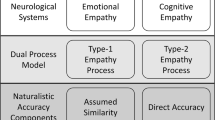–
This preliminary study investigated the effect of emotional distance on psychophysiologic concordance and perceived empathy in a clinical population. Participants included 20 adult outpatients from a mental health clinic that underwent a brief semi-structured interview with a trained psychiatrist in either an emotionally neutral or an emotionally distant condition. Simultaneous skin conductance (SC) levels of the patient and interviewer were recorded and used to calculate a measure of psychophysiologic concordance. Interviewer gaze was rated by an independent observer and used as a proxy indicator of emotional distance. Observer ratings of interviewer gaze, SC concordance, and patient ratings of perceived interviewer empathy were significantly lower in the emotionally distant condition compared with the emotionally neutral condition (p < 0.05). Results suggest that increased emotional distance is associated with decreased psychophysiologic concordance and reduced subjective ratings of perceived empathy. The observed differences in psychophysiologic concordance support the use of this measure as a potential marker of empathy in a clinical population in an interview setting.


Similar content being viewed by others
REFERENCES
Arnetz, B. B. (2001). Psychosocial challenges facing physicians of today. Social Science and Medicine, 52, 203–213.
Barrett-Lennard, G. T. (1962). Dimensions of therapist response as causal factors in therapeutic change. Psychological Monographs: General and Applied, 76(43), 1–36.
Benbassat, J., & Baumal, R. (2004). What is empathy and how can it be promoted during clinical clerkships? Academic Medicine, 79(9), 832–839.
Berber, S. M. (1962). Conditioning through vicarious instigation. Psychological Review, 9(5), 450–466.
Bohart, A. C., & Greenberg, L. S. (1997). Empathy and psychotherapy: An Introductory overview. In L. S. Greenberg (Ed.), Empathy reconsidered: New directions for psychotherapy (pp. 3–31). Washington, DC: American Psychological Association.
Brothers, L. (1989). A biological perspective on empathy. American Journal of Psychiatry, 146(1), 10–19.
Buck, R., & Ginsburg, B. (1997). Communicative genes and the evolution of empathy. In W. J. Ickes (Ed.), Empathic accuracy (pp. 17–43). New York, NY: Guilford Press.
Cacioppo, J. T., & Gardner, W. L. (1999). Emotion. Annual Review of Psychology, 50, 191–214.
Cacioppo, J. T., & Petty, R. E. (1981). Attitudes and cognitive response: An electrophysiologic approach. Journal of Personality and Social Psychology, 37, 2181–2199.
Calia, R. (2004). ‘Only connect’: The centrality of doctor-patient relationships in primary care. Family Practice, 21(3), 232–233.
Cape, J. (2001). Patient-rated therapeutic relationship and outcome in general practitioner treatment of psychological problems. British Journal of Clinical Psychology, 39(4), 383–395.
Carr, L., Iacoboni, M., Dubeau, M., Mazziotta, J. C., & Lenzi, G. L. (2003). Neural mechanisms of empathy in humans: A relay from neural systems for imitation to limbic areas. Proceedings of the National Academy of Science, 100(9), 5497–5502.
Cohen, J. (1988). Statistical power analysis for the behavioral sciences (2nd ed.). Hillsdale, NJ: Erlbaum Associates.
Cohn, J. F., & Tronick, E. Z. (1988). Mother-infant face-to-face interaction: Influence is bidirectional and unrelated to periodic cycles in either partner's behavior. Developmental Psychology, 24(3), 386–392.
Coleman, R., Greenblatt, M., & Solomon, H. C. (1956). Physiolgical evidence of rapport during psychotherapeutic interviews. Diseases of the Nervous System, 17, 71–77.
Craig, K. D. (1968). Physiologic arousal as a function imagined, vicarious, and direct stress experiences. Journal of Abnormal Psychology, 73, 513–520.
Craig, K. D., & Lowery, H. J. (1969). Heart-rate components of conditioned vicarious affective arousal. Journal of Personality and Social Psychology, 11, 381–387.
Critchley, H. D., Elliott, R., Mathias, C. J., & Dolan, R. J. (2000). Neural activity relating to generation and representation of galvanic skin conductance responses: A functional magnetic resonance imaging study. Journal of Neuroscience, 20(8), 3033–3040.
Crosbie, J. (1995). Interrupted time-series analysis with short series: Why it is problematic; how it can be improved. In J. M. Gottman (Ed.), The analysis of change (pp. 361–395). Mahwah, NJ: Lawrence Erlbaum Associates.
de Roten, Y., Fivaz-Depeursinge, E., Stern, D. J., Darwish, J., & Corboz-Warnery, A. (2000). Body and gaze formations and the communicational alliance in couple-therapist triads. Psychotherapy Research, 10(1), 30–46.
Decety, J., & Chaminade, T. (2003). Neural correlates of feeling sympathy. Neuropsychologia, 41, 127–138.
Di Mascio, A., Boyd, R. W., & Greenblatt, M. (1957). Physiological correlates of tension and antagonism during psychotherapy: A study of “interpersonal change”. Psychosomatic Medicine, 19(2), 99–104.
Di Mascio, A., Boyd, R. W., Greenblatt, M., & Solomon, H. C. (1955). The psychiatric interview: A sociophysiologic study. Diseases of the Nervous System, 16, 4–9.
Farrow, T., Zheng, Y., Wilkinson, I., Spence, S., Deakin, J., Tarrier, N., et al. (2001). Investigating the functional anatomy of empathy and forgiveness. Neuroreport, 12, 2433–2438.
Field, T., Healy, B., Goldstein, S., & Guthertz, M. (1990). Behavior-state matching and synchrony in mother-infant interactions of nondepressed versus depressed dyads. Developmental Psychology, 26(1), 7–14.
Fredrickson, M., Furmark, T., Olsson, M. T., Fischer, H., Andersson, J., & Langstrom, B. (1998). Functional neuratomical correlates of electrodermal activity: A positron emission tomographic study. Psychophysiology, 35, 179–185.
Hammond, D. C., Hepworth, D. H., & Smith, V. G. (2002). Improving therapeutic communication: A guide for developing effective techniques. San Francisco.
Hugdahl, K. (1995). Electrodermal activity. In K. Hugdahl (Ed.), Psychophysiology: The mind-body perspective (pp. 101–130). Cambridge, MA: Harvard University Press.
Jaffe, J., Beebe, B., Feldstein, S., Crown, C. L., Jasnow, M., Rochat, P., et al. (2001). Rhythms of dialogue in infancy. Monographs of the Society for Research In Child Development, 66(2), 1–148.
Kleinke, C. L., Staneski, R. A., & Berger, D. E. (1975). Evaluation of an interviewer as a function of interview gaze, reinforcement of subject gaze, and interviewer attractiveness. Journal of Personality and Social Psychology, 31, 115–122.
Kohler, E. (2002). Hearing sounds, understanding actions: Action representation in mirror neurons. Science, 297, 846–848.
Lacey, J. I. (1959). Psychophysiological approaches to the evaluation of pscyhotherapeutic process and outcome. In E. A. Rubinstein & M. B. Parloff (Eds.), Research in psychotherapy (pp. 160–208). Washington, DC: National Publishing Co.
Levenson, R. W., & Gottman, J. M. (1983). Marital interaction: physiological linkage and affective exchange. Journal of Personality and Social Psychology, 45(3), 587–597.
Levenson, R. W., & Gottman, J. M. (1985). Physiological and affective predictors of change in relationship satisfaction. Journal of Personality and Social Psychology, 49(1), 85–94.
Levenson, R. W., & Ruef, A. M. (1992). Empathy: A physiological substrate. Journal of Personality and Social Psychology, 63(2), 234–246.
Levinson, W. (1994). Physician–patient communication: A key to malpractice prevention. Journal of the American Medical Association, 272, 1619–1620.
Lidberg, L., & Wallin, B. G. (1981). Sympathetic nerve discharges in relation to amplitude of skin resistance responses. Psychophysiology, 18, 268–270.
Malin, M., Hemminki, E., Raeikkoenen, O., Sihvo, S., & Peraelae, M. L. (2001). What do women want? Women's experiences of infertility treatment. Social Science and Medicine, 53(1), 123–133.
Marci, C. D., Ham, J., Moran, E. K., & Orr, S. P. (2006). Physiologic correlates of empathy and social-emotional process during psychotherapy. Manuscript in preparation.
McCarron, L. T., & Appel, V. H. (1971). Categories of therapist verbalizations and patient-therapist autonomic response. Journal of Consulting and Clinical Psychology, 37(1), 123–134.
Mechanic, D., McAlpine, D. D., & Rosenthal, M. (2001). Are patient's office visits with physicians getting shorter? New England Journal of Medicine, 344(3), 198–204.
Miller, G. (2005). Reflecting on another's mind: Mirror mechanisms built into the brain may help us understand each other. Science, 308, 945–947.
Mohr, D. (1995). Negative outcome in psychotherapy: A critical review. Clinical Psychology: Science and Practice, 2, 1–27.
Nerdrum, P. (1997). Maintenance of the effect of training in communication skills: A controlled follow-up study of level of communicated empathy. British Journal of Social Work, 27(5), 705–722.
Ochsner, K. N., & Feldman Barrett, L. (2001). A multiprocess perspective on the neuroscience of emotion. In G. A. Bonanno (Ed.), Emotions: Current issues and future directions (pp. 38–81). New York, NY: Guilford Press.
Oppenheim, A. V., & Schafer, R. W. (1999). Discrete-time signal processing. Upper Saddle River, NJ: Prentice-Hall.
Patterson, J. C., Ungerleider, L. G., & Bandettini, P. A. (2002). Task-independent functional brain activity correlation with skin conductance changes: An fMRI study. Neuroimage, 17, 1797–1806.
Robinson, J. W., Herman, A., & Kaplan, B. J. (1982). Autonomic responses correlate with counselor-client empathy. Journal of Counseling Psychology, 29(2), 195–198.
Roessler, R., Bruch, H., Thum, L., & Collins, F. (1975). Physiologic correlates of affect during psychotherapy. American Journal of Psychotherapy, 29, 26–36.
Siepmann, M., Grossmann, J., Muck-Weymann, M., & Kirch, W. (2003). Effects of sertraline on autonomic and cognitive functions in healthy volunteers. Psychopharmacology, 168(3), 293–298.
Singer, T., Seymour, B., O’Doherty, J., Kaube, H., Dolan, R. J., & Frith, C. D. (2004). Empathy for pain involves the affective but not the sensory componenets of pain. Science, 303, 1157–1161.
Stanek, B., Hahn, P., & Mayer, H. (1973). Biometric findings on cardiac neurosis: Changes in ECG and heart rate in cardiopathic patients and their doctor during psychoanalytical initial interviews. Psychotherapy and Psychosomatics, 22, 289–299.
Strug, D., Ottman, R., Kaye, J., Saltzberg, S., Walker, J., & Mendez, H. (2003). Client satisfaction and staff empathy at pediatric HIV/AIDS programs. Journal of Social Service Research, 29(4), 1–22.
Sung, M., Marci, C. D., & Pentland, A. (2005). Wearable feedback systems for rehabilitation. Journal of NeuroEngineering and Rehabilitation, 2, 2–17.
Thorell, L. H., Kjellman, B., & D’Elia, G. (1987). Electrodermal activity in relation to diagnostic subgroups and symptoms of depressive patients. Acta Psychiatrica Scandinavica, 76(6), 693–701.
Thorell, L. H., Kjellman, B. F., & d’Elia, G. (1987). Electrodermal activity in antidepressant medicated and unmedicated depressive patients and in matched healthy subjects. Acta Psychiatrica Scandinavica, 76, 684–692.
Tronick, E. Z., Brushweiler-Stern, N., Harrison, A. M., Lyons-Ruth, K., et al. (1998). Dyadically expanded states of consciousness and the process of therapeutic change. Infant Mental Health Journal, 19(3), 290–299.
van Dulmen, A. M., & Bensing, J. M. (2002). Health promoting effects of the physician–patient encounter. Psychology, Health and Medicine, 7(3), 289–300.
Vaughan, K. B., & Lanzetta, J. T. (1980). Vicarious instigation and conditioning of facial expressive and autonomic responses to a model's expressive delay of pain. Journal of Personality and Social Psychology, 38(6), 909–923.
ACKNOWLEDGMENTS
Funding for this project comes from NIMH F32MH072073–01 and an unrestricted grant from the Massachusetts General Hospital Endowment for the Advancement of Psychotherapy.
Author information
Authors and Affiliations
Corresponding author
Rights and permissions
About this article
Cite this article
Marci, C.D., Orr, S.P. The Effect of Emotional Distance on Psychophysiologic Concordance and Perceived Empathy Between Patient and Interviewer. Appl Psychophysiol Biofeedback 31, 115–128 (2006). https://doi.org/10.1007/s10484-006-9008-4
Published:
Issue Date:
DOI: https://doi.org/10.1007/s10484-006-9008-4




